
The Natural Building Colloquium- 2015
by Kelly Hart
In the Fall of 2015 I attended an intensive week of immersion in the varied world of natural building at the Natural Building Colloquium in Kingston, New Mexico. The Black Range Lodge hosted this event, the fourth one that has occurred there, and the fourth that I have attended. Between 150 and 170 folks were there, many of them long-time pillars of this diverse community of enthusiasts.
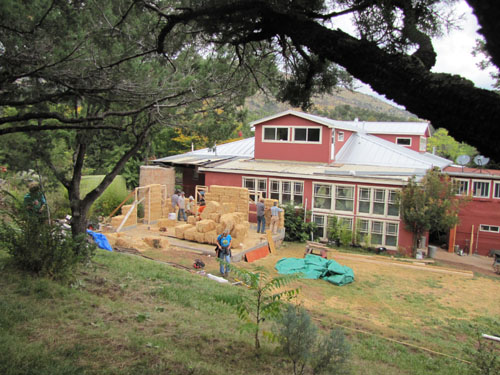
The first Colloquium was in 1995 and was organized as a way to get folks together so they could have time to become acquainted and share information. The idea was that if people had this opportunity it would not only advance the art of natural building, but it might quell the tendency for competing factions to form and create discord or animosity among practitioners. I think that this intention has been realized to a great extent; we really have become a close-knit family that is aligned with the purpose of spreading the word of how the natural building movement can help move society towards a more sustainable future. It was an international event, with representatives from all of the Americas, Japan, Taiwan, South Korea, Nepal and Europe.
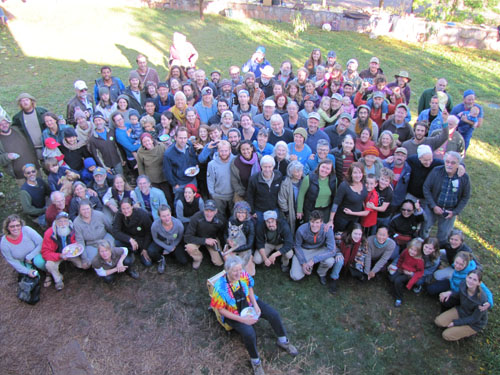
The schedule was jam packed with hands-on workshops, slide presentations, discussion groups, soap box speeches, walks and exercise, and entertainment, all interspersed with breaks for delicious food catered by a capable kitchen staff. There was much more going on than any person could participate in, so we constantly needed to make choices about where to go next. Often people opted to just hang out together and talk.
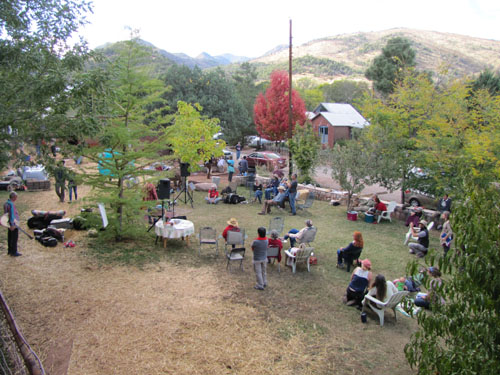
There was room at the Lodge for only a handful of people, so most attendees brought tents for camping. I had my little RV as a personal retreat space. Some evenings I could hear conversation, music and singing around a camp fire until the wee hours. Mostly the weather was quite nice, but there were a couple of days and nights where Mother Nature dumped rain or hail over the scene. This did not seem to bother the family of wild turkeys I saw strutting down the road.
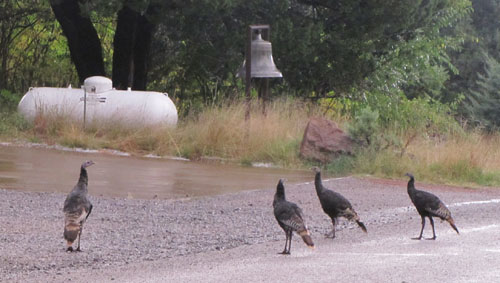
Every morning we gathered in a circle to share highlights of the previous day, general announcements and scheduling to help orient us for the day. Anyone new to the group was introduced.

During one of the early morning circles Sunray Kelley pointed up the hill to a group of trees and explained that he would be building a tree house there and that people were welcome to join him in the project. It didn’t take him long to attract a group of helpers willing to go around scrounging structural elements for this.
Sunray is a well known character around previous colloquia and a famous artist/builder in his own right. He grew up in the woods of Washington State and still resides on the family property, where he gleans material for most of the building that he has done there. I have never seen him wear shoes.
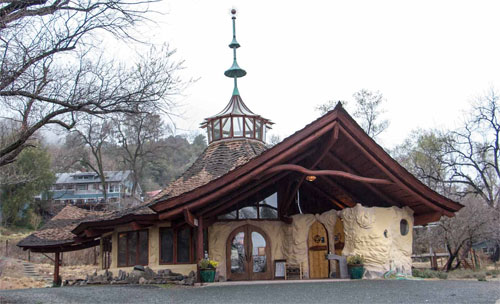
One of his better known projects was a temple at Harbin Hot Springs in California. This lovely example of Sunray’s artistry unfortunately burned to the ground in the recent wild fire that razed much of that historic site.
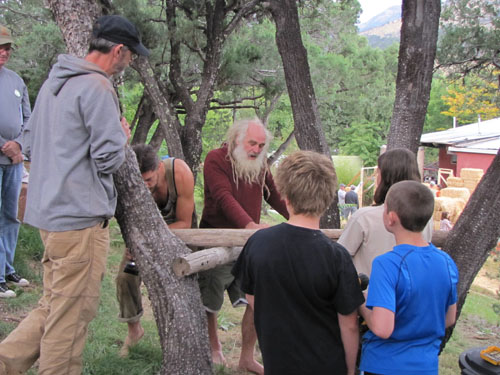
Sunray’s approach to building this tree house was rather spontaneous, just following some sort of vision that he had in his mind. I think that much of his construction proceeds in a similar manner. He directed the whole process and it happened quite smoothly, with volunteers attaching parts as needed.

Some of the construction required deft acrobatics to accomplish. Many of the support beams were attached to the tree with hefty longs screws that could be driven with a battery operated driver. Occasionally Sunray would use a small electric chain saw to get a better fit.

For a roof some long live edge thin slabs were cut on a local band saw and these were overlapped as seen in the background. The concept behind this tree house was mainly as a play structure, so no attempt was made to thoroughly enclose it from the weather.
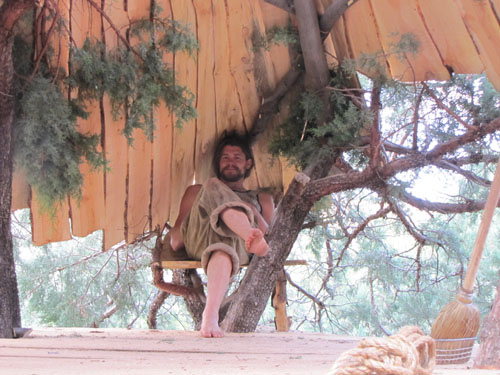
A built-in seat was fashioned in one corner of the little house.

From a distance the tree house really fit into the landscape without disrupting the form of the trees. A long ramp from the hill above provides access and tree branches protrude through the roof. There is an open skylight at the apex of the conical roof.

The tree house became a favorite place for both kids and adults to spend some quiet time away from all of the activity at the Colloquium.
One of the ongoing workshops at the Natural Building Colloquium was the construction of a unique Rocket Stove design that incorporated both a large barrel oven and a huge griddle for baking and cooking. This was a joint project of Max Edleson (of www.firespeaking.com) and Flemming Abrahamsson from Denmark. The unit would become part of a covered outdoor kitchen that will serve the Black Range Lodge for many years to come.
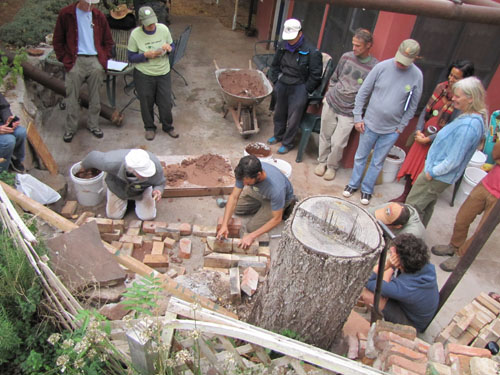
In the above photo you can see them just beginning to lay out the initial bricks on the concrete base. The fire box was on one end and the chimney was opposite this on the other end. The bricks were mortared with a clay and sand mix. It didn’t take them long to build up the brick enclosure with the barrel oven embedded in it.
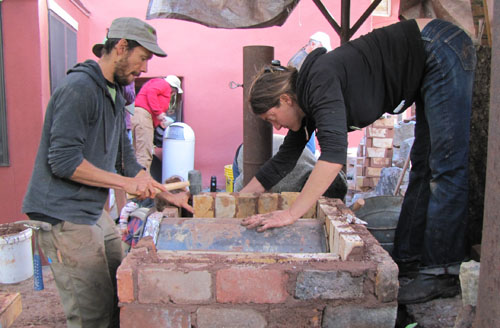
You can see how fire bricks were used as an inner liner and ordinary bricks protected the shell of the enclosure. The hot fire gasses were forced to circle around the oven before exiting at the base of the opposite side.

As a culmination of the project and proof of the concept you can see how a tasty brunch of toast, pancakes and sauteed vegetables were cooked on the top griddle. Unseen in the oven are a bunch of yams baking. Yum!
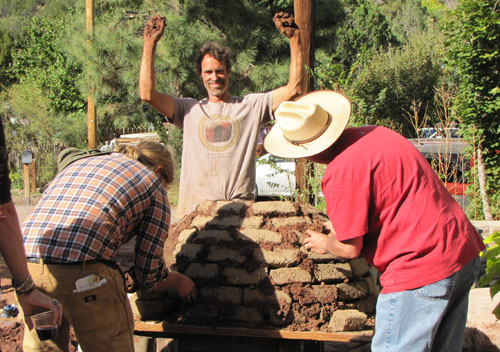
At a different location this demonstration of how to build a simple cob and brick oven is nearing completion.
In addition to the tree house and rocket stove projects already described, there were quite a few other hands-on demonstration projects happening at the Natural Building Colloquium (NBC), and I’ll describe a few of these.

A simple straw bale wall was erected on a prepared concrete foundation; this was directed by Bill Steen with the assistance of Matts Myhrman and many others. This L-shaped wall would immediately serve as a kind of performance stage and could eventually be enclosed for a building. The same wall was used for demonstrating earthen plaster with Sasha Rabin. Jacob Rascusin and Ace McArleton also demonstrated how plaster can be used as an effective air barrier.

A rainwater harvesting system was installed under the direction of Asher Gelbart, using several large tanks connected together. It was actually put to use during the week of the Colloquium when we were blessed by about half an inch of rain.

Steve Chappell of the Fox Maple School of Traditional Building demonstrated how to scribe a post to fit perfectly on a stone base, as might be done for a post and beam foundation. It took several people to wrestle this stone into an earthen socket.
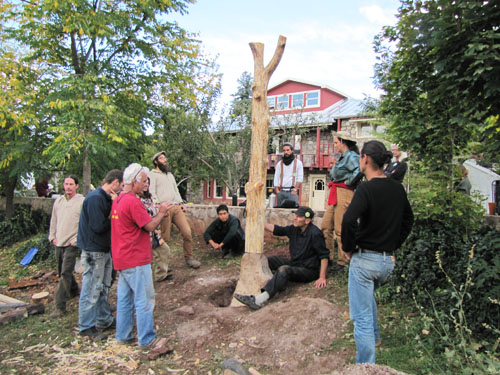
After several hour of careful measurement and carving to match the post to the stone, the post eventually stood perfectly erect without any other support. When I suggested that a steel pin could be used to make the monument a permanent attraction, Steve said that he was too much a purest to ever do that.
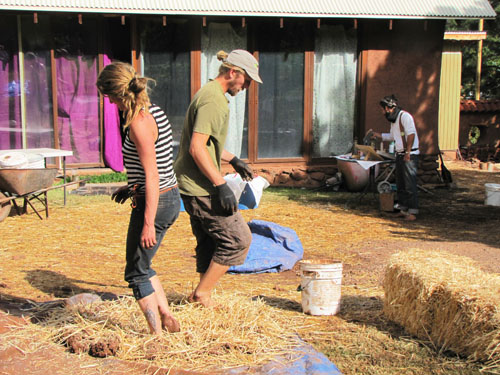
There were several projects that used cob, which is a mixture of clay, sand and straw. An effective way of mixing these ingredients together is to do the cob dance on a tarp, which is occasionally lifted to roll the mass and mix it further.
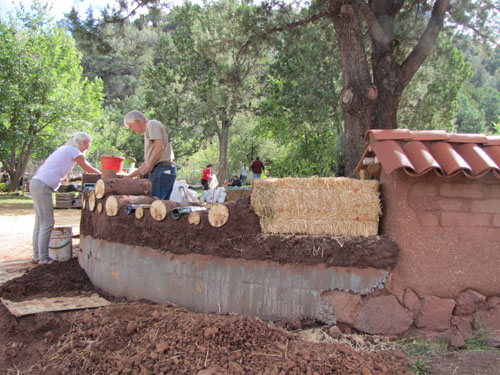
One of the recipients of the cob can be seen in this demonstration “cobwood” wall at the entrance of the Lodge. Rob and Jaki Roy, of the Earthwood Building School can be seen laying out the initial log ends. As a foundation for both the cordwood and straw bale is a preexisting poured concrete stem wall with one course of gravel-filled earthbags on top of it. I prepared the earthbags (with the help of a volunteer); Kaki Hunter and Doni Kiffmeyer demonstrated another earthbag retaining wall nearby. The little wall will eventually be topped by some terra cota tiles to protect it from the weather.
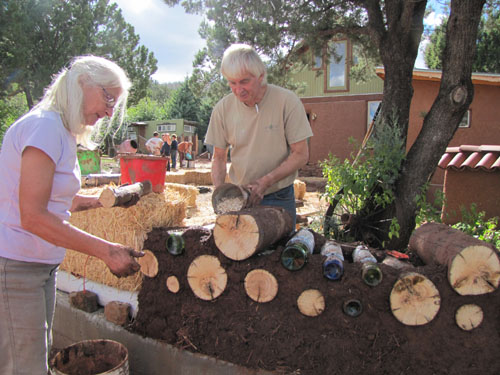
In the above photo Jaki is about to place a small log end in the wall, while Rob pours sawdust and lime insulation in the central void, as is traditionally done with insulated walls. You can also see several coupled bottle ends laid into the wall as part of the decoration. One night they demonstrated how a flashlight can be swept across the back of the wall, providing a mesmerizing light show on the opposite side.
Besides the workshops described above, there were at least an equal number that I was unable to document; there were simply too many things going on to do it all!
Along with all of the the outdoor hands-on workshops at the Natural Building Colloquium were even more indoor presentations, mostly accompanied by slides. I had two opportunities to do presentations myself, both about earthbag building around the world. These were well received and people were amazed at the extraordinary variety of earthbag projects on every continent.
Robert LaPorte and Paula Baker-LaPorte, a design/build team did a nice retrospective of the work they have done under the banner of EcoNest. They have specialized in light straw/clay building.
Jacob Racusin, one of the authors of The Natural Building Companion did a two part presentation about building science for natural builders that had many people talking about it for days.
Ziggy Liloia, blogger on The Year of Mud, did a very moving presentation about his tribulations with building his first cob home at Dancing Rabbit in Missouri. I was quite impressed with his willingness to reveal the many costly mistakes that he had made along the way.

Art Ludwig with David Eisenberg in the backgroung
An intensive two part discussion about building codes was presented by David Eisenberg (of The Development Center for Appropriate Technology), Art Ludwig (of Oasis Design), Martin Hammer (of Builders without Borders) and Bruce King, an engineer. Bruce King also did a presentation entitled Natural Building, Unnatural Building, and the future of Building, with many worthwhile insights.
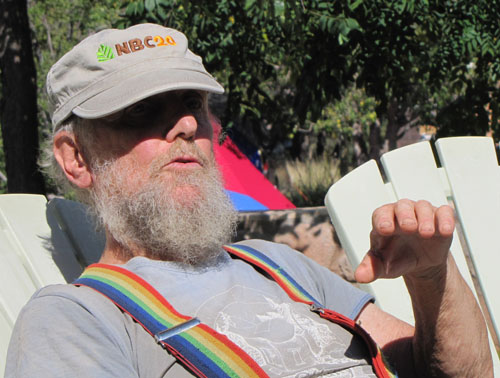
Linda Smiley and Ianto Evans did another retrospective of the work of the Cob Cottage Company, which literally introduce cob building to North America many years ago. Bill Steen of the Canelo Project talked about what they have learned about straw and clay over the years. Chris Magwood (of the Endeavor Center), along with Jacob Racusin presented about cold climate natural building as well as about low carbon design and construction. Rob and Jaki Roy did a retrospective look at what they have done at the Earthwood Building School in New York, especially with cordwood construction. Randolph Langenbach, an architect specializing in historic preservation, presented on Traditional is Modern; What Natural Buildings can Teach Us. I found this particularly informative regarding traditional elements that can enhance seismic resilience. Flemming and Karen Abrahamsson presented about natural building in Denmark. Matts Myhrman did a particularly humorous presentation about Historic Nebraska Bale Buildings: Images and Inspiration.
What I have mentioned here is really only about half of all the presentations. This is intended to just give a taste of the breadth of information imparted by so many pillars of the natural building community.
Catherine Wanek, who was the host of the entire Colloquium at the Black Range Lodge, did a presentation about the history and work of Builders without Borders. Janell Kapoor of Kleiwerks Internlational did a retrospective of the wonderful work they have done around the world.
One of the most significant contributions that I was able to make at the Colloquium occurred in conjunction with a presentation about what Builders Without Borders is doing in Nepal to help with reconstruction efforts there. This presentation was done by three individuals, all shown in the photo below.
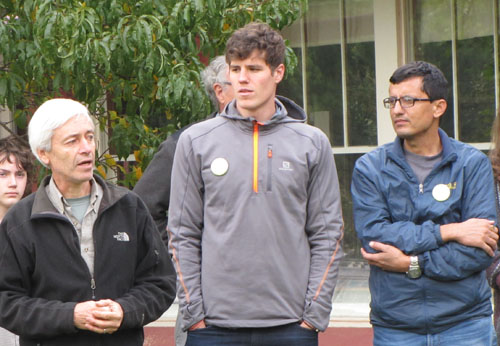
On the left is Martin Hammer, the current director of Builders Without Borders; in the middle is a young architect who recently returned from Nepal having initiated a multi-story urban residential unit using confined masonry within reinforced concrete; on the right is Parshu Dahal, who is a Nepali slated to receive assistance from the Builders Without Borders organization.
This organization has primarily been focused on the use of straw bales for reconstructing Haiti, Pakistan, and now Nepal, so the presentation reflected that orientation. Various presses for creating straw bales were described and the pros and cons of this approach were discussed.
I wanted to show them what I knew about the extensive use of earthbags for rebuilding in Nepal, but there wasn’t time at the first presentation. Fortunately, there was a Design Charette for rebuilding Nepal scheduled for later in the week and I arranged to make a presentation about earthbags there.
Before the Colloquium I had prepared an extensive review of earthbag building around the world as a slide show to share with participants. At the end of this show I had collected many images and facts that detailed what has transpired in Nepal, emphasizing the fact that none of the existing earthbag structures had suffered much damage from the quake, even though most buildings around them had collapsed. Folks were generally not aware of this, so it immediately got their attention.
Afterward, I had a chance to talk to Parshu, the Nepali aid recipient, and he told me how impressed he was with the whole concept of earthbag building. I gave him my book about Earthbag Architecture so he could find out more about it. The next day he told me he definitely wanted to build with earthbags. He felt that not only would it be safer than the traditional stone and mortar, but that it would be cheaper and easier to do and to acquire the needed materials.
Also in the audience of the Design Charette was Randolph Langenbach, an architect specializing in historic preservation who recently returned from filming in Nepal with a crew from NOVA. He also was impressed with earthbags as a technique for rebuilding in Nepal, and he had some specific suggestions for improving these. I am continuing to correspond with Randolph and expect to report in more detail about this soon.
On the whole, I think that my presentation was able to make an impression on the Builders Without Borders organization that will change the way they continue with their work.
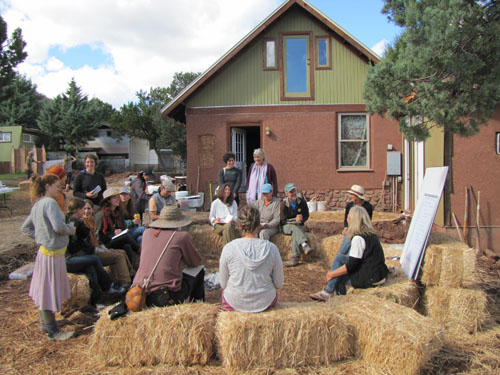
Besides all of the workshops and presentations already mentioned, there were a number of fairly spontaneous breakout groups or conversations. I participated in a couple these; one was about the future of book publishing, but the most interesting one was looking at how we can bring natural building more into mainstream acceptance. This turned out to be a three day ongoing brainstorm with up to a dozen people at each session.
Janell Kapoor of Kleiwerks International proposed this discussion and it attracted many of the seasoned movers and shakers of the natural building movement. Joe Kennedy became the scribe, keeping 9 pages of notes of comments as they emerged.
Janell suggested doing a SWOT analysis, or looking at strengths, weaknesses, opportunities and threats to accomplishing the goal of advancing natural building to become more commonly accepted practice. Rather than outline all of the collected suggestions, I will give you my opinion about these aspects.
I think that the greatest strength is that the natural building movement directly addresses many of the issues that confront humanity in terms of energy use and pollution, especially as these contribute to global climate change. The biggest weakness is the perception of the general public that natural building is substandard, unsafe, backward, too counter-culture, and even expensive. We have a tremendous opportunity to educate the masses through all forms of media that natural building can be beautiful, practical, durable, energy efficient and affordable. A major threat to realizing this are the entrenched industrial interests that often control how the codes are formulated and promote industrial solutions to housing.
What has recently happened in Nepal regarding earthbag building and how it is suddenly being accepted by both the populace and the government as an appropriate solution to rebuilding that shaken nation is a perfect example of how natural building can come into mainstream focus. This resulted from practical demonstration and media attention. These kinds of events can alter the cultural stories that are told over generations and make real change happen.
Another example of mainstream attention is the tiny house phenomenon; most everybody has been exposed to this building choice within the last few years. I think the popularity of tiny houses comes from two directions: they are adorable and they are relatively affordable. Most people want to own their own homes and a tiny house might be the answer, whereas standard housing is out of the question. When you get right down to basic motivation, economics always runs the show. We need to make natural building affordable or it will not flourish. I think that in the end natural building will grow in popularity for the very reason that it can be an affordable way to address our housing needs with minimal energy and industrial material consumption.
The last day of the Natural Building Colloquium was open to the general public as the Art of Natural Building Faire. We started out our day with the usual morning circle where several of the key organizers of the Colloquium were honored. This included Michael G. Smith who coordinated the entire schedule for the week; he did an excellent job of this.
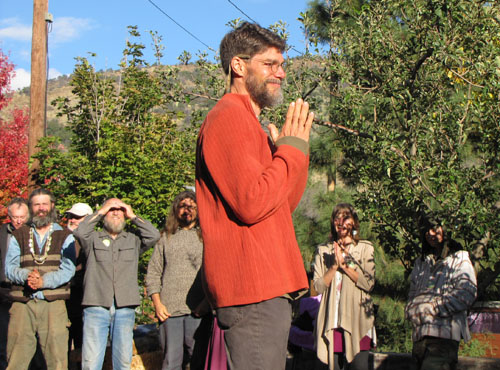
Michael G. Smith was honored for his service in coordinating the Colloquium.

Catherine Wanek was presented with a special gift of a Nepali ringing bowl by Parshu.
As part of the Faire we had tables of books written by many of the participants where autographed copies were available. Some of the authors also made short presentations about their books. I had the three books available as part of my Green Home Building series and I sold a few of these.
The public had many choices for activities, including tours of local natural building attractions, hands-on demonstrations, and a number of slide show presentations. Joe Kennedy and I co-presented about earthbag building and that was very well received.
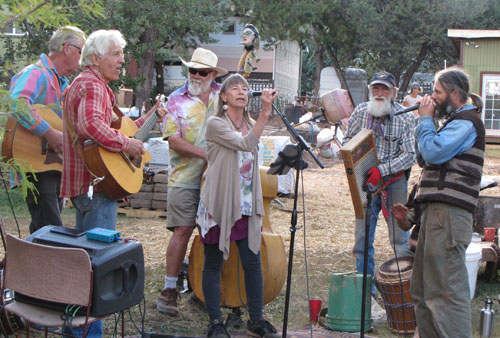
Catherine Wanek sang the “T or C Blues.” T or C is also known as Truth or Consequences, a nearby town. Live music was provided by Tim Weed and a group of participant musicians that included Matts Myhrman on the washboard.
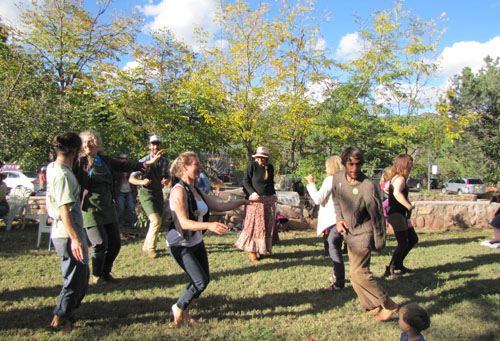
The live music got people up to dance to the lively rhythm.
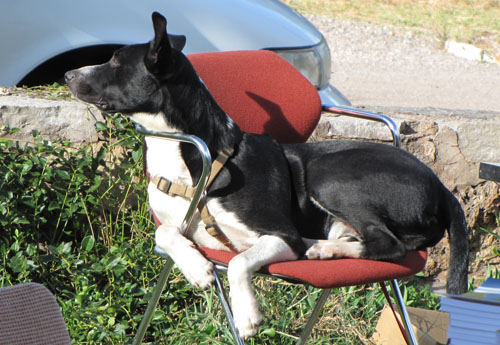
This dog saw no reason to get up off of his comfy chair.
The Art of Natural Building Faire, with all of its festivities, was a fitting finale for what was a magnificent week of immersion into the world of Natural Building. We came together with common interests and emerged as a united family with strong bonds that will last for years.

For Email contact go to About Us
Established in 2001, GreenHomeBuilding.com is primarily a labor of love. Kelly, and the GreenHomeBuilding team of experts, have answered thousands of questions for readers over the years, and we continue to publish up-to-date information about increasingly important sustainable architecture. If you feel moved to assist us in this work, your kind donation would be much appreciated; this can be easily done through our PayPal account:

VISIT OUR OTHER WEBSITES:
[Natural Building Blog] [Earthbag Building] [Dream Green Homes]
Disclaimer Of Liability And Warranty
I specifically disclaim any warranty, either expressed or implied, concerning the information on these pages. Neither I nor any of the advisor/consultants associated with this site will have liability for loss, damage, or injury, resulting from the use of any information found on this, or any other page at this site. Kelly Hart, Hartworks LLC.
